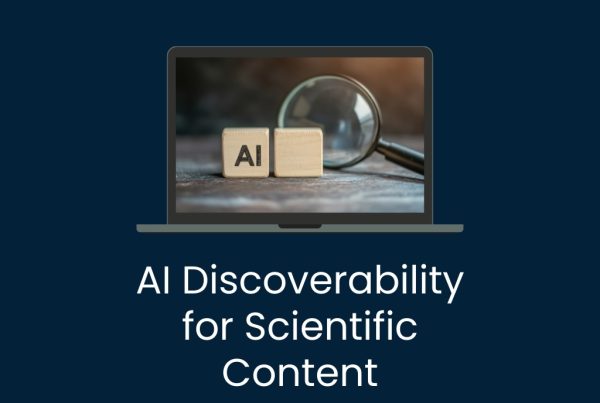Life Science Content Visibility: From SEO to LLMO—New Rules for AI-Driven Discovery
Ready to make your content truly discoverable? The science of visibility has evolved fast—from classic SEO to AI-centric strategies like LLMO—and for life science tool marketers, the stakes have never been higher. The question isn’t just “Will I rank?” but “Will I be the answer AI platforms provide to scientists everywhere?
The Evolution of Discoverability in Life Sciences
In the early digital days, content visibility was all about SEO. Then came AEO for direct answers, AIEO to appeal to AI-powered assistants, GEO for generative engine influence, and now LLMO to ensure large language models actually learn from your scientific assets.
Each strategy helps your content break through the noise in very different ways.
It’s no longer enough to just publish and pray—your content must be findable, trustworthy, and surfaced by both legacy search engines and today’s sophisticated AI platforms.
The Ultimate Guide: Five AI Optimization Acronyms Every Life Science Marketer Should Master
To thrive in today’s AI-driven landscape, marketers need to master five core optimization strategies that shape how scientists discover content online and through AI assistants. Here’s what those acronyms mean and why they’re game changers:
📈 SEO: Search Engine Optimization
What This Means:
SEO is the practice of improving your website and content so it ranks higher on classic search engines like Google.
Focus:
- Use relevant keywords (such as specific research applications or product types).
- Build backlinks from credible sites (scientific journals, lab directories).
- Optimize meta tags and content structure.
Life Science Example:
Imagine a scientist searching for “best qPCR machines for gene expression analysis.” If your landing page uses that keyword, includes comparison tables, and has citations from publications, it can show up at the top of Google results—driving targeted traffic to your site.
Why It Matters:
SEO is still fundamental for capturing organic interest from life science researchers starting with a search—helping you become the first brand they discover.
💬 AEO: Answer Engine Optimization
What This Means:
AEO is about structuring your content so it’s eligible to be pulled directly into Google’s answer boxes, “People Also Ask” panels, and other instant Q&A formats.
Focus:
- Directly answer common questions in simple, well-formatted language.
- Use FAQ pages, clear definitions, and bullet-point summaries.
Life Science Example:
A scientist Googles, “What is the difference between monoclonal and polyclonal antibodies?” Your site’s concise Q&A page could appear as the featured snippet—showing your expertise and driving credibility long before a click.
Why It Matters:
AEO helps your company win “position zero,” capturing scientists’ attention and building brand authority even if they don’t visit your website.
🤖 AIEO: AI Engine Optimization
What This Means:
AIEO means formatting your content so that AI assistants like ChatGPT, Gemini, or specialized lab AI tools can accurately “read” and recommend your information when users ask research or purchasing questions.
Focus:
- Write with clarity, authority, and explicit details.
- Make services, benefits, and differentiators easy for AI systems to extract and cite.
Life Science Example:
A scientist asks an AI, “Which antibody vendors provide validation proof?” If your website has a dedicated, well-structured page explaining your validation methodology—using clear language and headings—the AI can extract this detail and recommend your company as a trusted option.
Why It Matters:
AI-driven recommendations are fast becoming a researcher’s first stop; you want to be the brand these systems cite.
📝 GEO: Generative Engine Optimization
What This Means:
GEO is about making your detailed content (protocols, workflows, how-to guides) easy for generative AI to build into comprehensive, step-by-step responses to scientist queries.
Focus:
- Publish detailed, well-labeled protocols and troubleshooting guides.
- Use language that’s procedural and instructional.
Life Science Example:
A researcher asks a lab AI: “How do I troubleshoot high background in a Western blot?” Your published troubleshooting steps—if formatted clearly as causes and solutions—could be woven directly into the AI’s step-by-step guide, with attribution to your brand.
Why It Matters:
When AIs use your protocols as their “playbook,” your company’s expertise becomes the backbone of the answers researchers trust.
🧠 LLMO: Large Language Model Optimization
What This Means:
LLMO involves shaping your structured content (datasets, protocols, publications) so it’s likely to be ingested by the LLMs (like OpenAI’s GPT) powering future AI assistants and research tools.
Focus:
- Ensure application notes, white papers, and data are formatted for machine-readability (using schema, tags, standardized vocabularies).
- Publish in reputable places where LLMs crawl and train.
Life Science Example:
Suppose you publish an application note describing optimal use of your flow cytometry reagents, making it available with clear metadata and citations. This content can get pulled into the biomedical datasets that LLMs use to “learn” about scientific best practices—making your recommendations part of the broader AI knowledge base.
Why It Matters:
LLMO is about long-term influence. As LLMs become the default guides for scientists, only well-structured and credible content will shape the next generation’s understanding of your products.
⚡Quick Comparison Table
| Acronym | What It Means | Main Focus | Life Science Example | Why It Matters |
| SEO | Search Engine Optimization | Rank higher on classic search engines (Google) | Blog on “Best ELISA Kits for Cytokine Analysis” | Drives organic traffic by matching researcher queries |
| AEO | Answer Engine Optimization | Win direct answers and featured snippets in Google | FAQ answering “What is flow cytometry used for?” | Captures top search visibility with instant Q&A answers |
| AIEO | AI Engine Optimization | Make AI assistants cite and trust your content | Clear page detailing antibody validation methodologies | Becomes the recommended source in AI-powered research tools |
| GEO | Generative Engine Optimization | Help AI build step-by-step answers using your content | Protocol integrated into AI-guided “How to” experiments | Your expertise forms the basis of AI-generated scientific guidance |
| LLMO | Large Language Model Optimization | Ensure LLMs ingest and weight your structured content | Publishing tagged application notes and peer-reviewed citations | Shapes future AI knowledge bases and long-term brand influence |
🌟 Why This Matters for Life Science Marketers
Scientists are shifting from traditional searching to direct questioning—whether in Google, AI-powered lab assistants, or purpose-built research platforms. Your visibility strategies now operate on three fronts:
- SEO/AEO: Secure a presence in classic queries and direct answers.
- AIEO/GEO: Become THE authoritative voice referenced in AI-driven discoveries.
- LLMO: Solidify your influence inside the next-gen knowledge base—future-proof your visibility as science itself gets redefined by AI.
The winners aren’t just found. They’re featured, cited, and form the backbone of the answers scientists rely on daily.
✨ How Aurora Biomarketing Can Help
At Aurora Biomarketing, we partner with life science tool companies to master this new era. With decades of experience in scientific communications and digital strategy, we help you structure, publish, and amplify your content to rank, resonate, and be cited by both humans and machines—spanning SEO, AIEO, GEO, and LLMO.
Because in the AI era, visibility means trust, authority, and discoverability everywhere scientists seek solutions. Make sure your story is the one AI—and your customers—tell.



